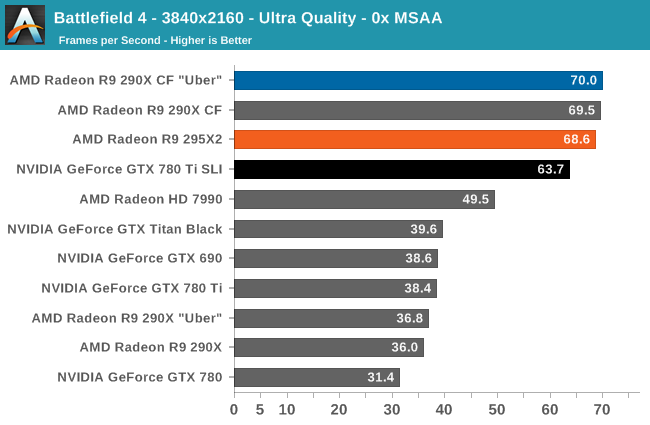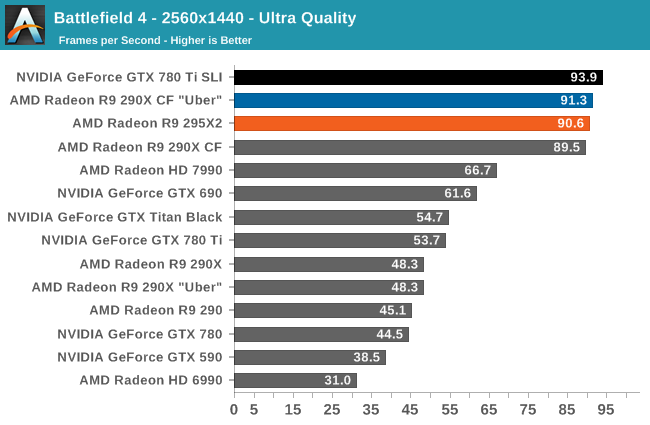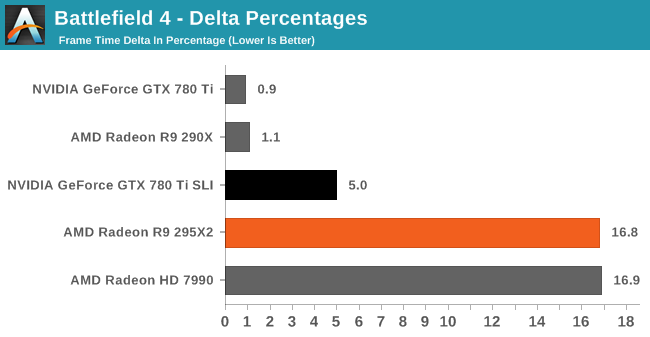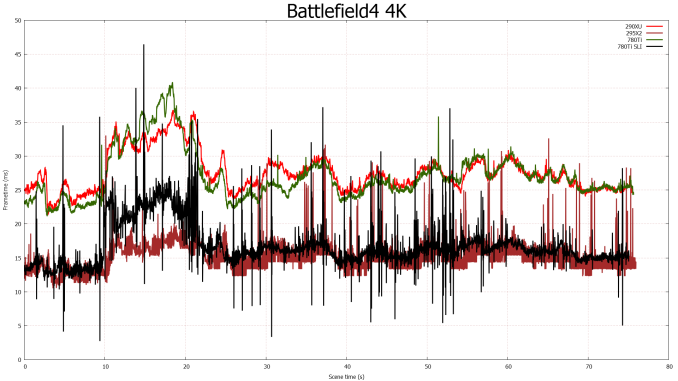The AMD Radeon R9 295X2 Review
by Ryan Smith on April 8, 2014 8:00 AM EST- Posted in
- GPUs
- AMD
- Radeon
- Radeon 200
Battlefield 4
Our current major multiplayer action game of our benchmark suite is Battlefield 4, DICE’s 2013 multiplayer military shooter. After a rocky start, Battlefield 4 has finally reached a point where it’s stable enough for benchmark use, giving us the ability to profile one of the most popular and strenuous shooters out there. As these benchmarks are from single player mode, based on our experiences our rule of thumb here is that multiplayer framerates will dip to half our single player framerates, which means a card needs to be able to average at least 60fps if it’s to be able to hold up in multiplayer.



As is the case in a few of our other games, whether it’s AMD who’s winning or NVIDIA who’s winning depends on the resolution. At 2160p with Ultra settings (and no MSAA) it’s AMD on top, with the 295X2 capable of delivering 68fps. This is safely past the 60fps threshold needed to ensure that minimum framerates don’t drop below 30fps in multiplayer. Otherwise at 1440p the NVIDIA GTX 780 Ti SLI setup pulls ahead, however the 295X2 is right on its tail.
In the meantime this game is also a good example of just how much faster than the 7990 the 295X2 is, despite the fact that both products are based on high-end (for their time) 28nm GPUs. The 295X2 ends up being over 40% faster at both 2160p and 1440p, showing just how far AMD has come in single card dual-GPU performance in the last year.


Shifting to our delta percentage benchmarks, we once more find that the 295X2 has no problem staying within the 20% threshold needed for smooth frame pacing. Though overall NVIDIA does hold an edge, especially at 1440p.












131 Comments
View All Comments
CiccioB - Tuesday, April 8, 2014 - link
Well, not, not exactly. One thing is not being PCI compliant, and that's a thing I can understand. Another thing is going beyond connectors electrical power specifications. If they put 3 connectors I would have not had any problem. But as it is they are forcing components specifications, not simple indications rules on maximum size and power draw.meowmanjack - Tuesday, April 8, 2014 - link
If you look at the datasheet for the power connector (I'm guessing on the part number but the Molex part linked below should at least be similar enough), each pin is rated for 23 A and the housing can support a full load on each pin. Even if only 3 pairs are passing current, the connector can deliver over 800W at 12V.The limiting factor for how much power can be drawn from that connector is going to be the copper width and thickness on the PCB. If AMD designed the board to carry ~20 A (which the presumably have) off each connector it won't cause a problem.
meowmanjack - Tuesday, April 8, 2014 - link
Oops, forgot the datasheethttp://www.molex.com/molex/products/datasheet.jsp?...
behrouz - Tuesday, April 8, 2014 - link
Thanks For Link,Finally My Doubts were Resolved.Ian Cutress - Tuesday, April 8, 2014 - link
Most of the power will be coming from the PCIe power connectors, not the lane itself. If you have 5/6/7 in a single system, then yes you might start to see issues without the appropriate motherboard power connectors.dishayu - Tuesday, April 8, 2014 - link
I'm yet to read the review but FIVE HUNDRED WATTS? WOW!Pbryanw - Tuesday, April 8, 2014 - link
I'd be more impressed if it drew 1.21 Jigawatts!! :)krazyfrog - Tuesday, April 8, 2014 - link
On the second last page, the second last chart is of load GPU temperature when it should be load load noise levels.piroroadkill - Tuesday, April 8, 2014 - link
Reasonable load noise and temps, high performance. Nice.You'll want to get the most efficient PSU you can get your mitts on, though.
Also, I would seriously consider a system that is kicking out 600 Watts of heat to be something you wouldn't want in the same room as you. Your AC will work overtime, or you'll be sweating your ass off.
A GPU for Siberia! But then, that's not really a downside as such, just a side effect of having a ridiculous amount of power pushing at the edges of this process node.
Mondozai - Tuesday, April 8, 2014 - link
"Reasonable noise and temps"? It is shockingly quiet during load for a dual GPU card. And it has incredibly low GPU temps, too.As for heat, not really, only if you have a badly ventilated room in general or live in a warm climate.